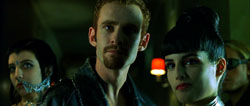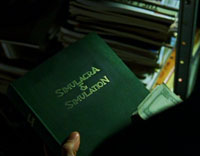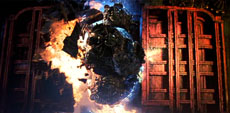 While I give some fascinating examples of "higher meanings" later on this page, I first wish to make what I feel is a very important point about the common commingling of higher meanings and plot function.
While I give some fascinating examples of "higher meanings" later on this page, I first wish to make what I feel is a very important point about the common commingling of higher meanings and plot function.
 While I give some fascinating examples of "higher meanings" later on this page, I first wish to make what I feel is a very important point about the common commingling of higher meanings and plot function.
While I give some fascinating examples of "higher meanings" later on this page, I first wish to make what I feel is a very important point about the common commingling of higher meanings and plot function.
Remember all of those literature "classics" you were required to read and analyze in high school? The Matrix movies contain more symbolism/references and deep religious/philosophical meanings than any of those books do (at least, any of the books I was required to read). Because of this, it is very easy to fall in the trap of thinking that various higher meanings hold the answers to plot function when they actually don't. Doing this is an insult to the brilliance of the Wachowskis.
Imagine a very large painting of Arizona's Grand Canyon that draws your gaze for a very long time due to its unbelievable realism. After staring at it for 3 minutes, you walk closer to the painting just out of curiosity. You then notice that the painting is somehow made up of several smaller pictures that each contain another layer of understanding or cleverness that relates to the painting itself. You wouldn't have noticed these embedded layers of the painting had you not stepped closer to look at them.
After very careful inspection, you see a portrait embedded of Ferde Grofe, the composer who wrote the Grand Canyon Suite. You start noticing several things like this and are amazed that such a great painting could be created at all, let alone being able to incorporate very clever symbolic layers in the process.
Now imagine another very large collage that maybe (?) seems to tell a story if you look at the various collage elements. While the story behind the collage elements may be interesting, the picture itself doesn't make as much visual sense when taken as a whole. It is just a collage.
The Matrix movies are like the painting: the painting itself is the primary work of art, while the hidden layers are secondary. I've seen some people analyze the Matrix movies as if it were the collage above: the hidden layers (the little individual pictures that make up the collage) are taken as the primary work of art, and the giant picture that they make up (if they make up any giant picture at all?) is treated as secondary. In other words, people perform intellectual gymnastics to make their plot-level understanding of the movies line up with prioritized deeper meanings they've discovered (or invented) and grown to love more than the movies themselves. This puts the cart before the horse.
In all three movies, the Wachowskis have created one of the greatest science fiction premises and stories ever created. You could be completely oblivious to the underlying symbolism of the movies and still understand the surface of the story, as it should be. Just as you don't need to know about Ferde Grofe to understand the visual beauty of the Grand Canyon painting, you don't need to know anything about Christianity, Buddhism or Greek mythology to appreciate the wonderful science fiction movies that they are.
While we tend to regard Star Trek and Star Wars as great science fiction classics, what more would you think of all those movies if literary devices embedded in them could stand their ground against literature classics such as Red Badge of Courage or Catcher in the Rye? They can't. But the Matrix movies can and do. The surface story of the Matrix movies alone would be equivalent (or I would even argue better) than the surface stories and depths of Star Trek and Star Wars movies.
Allow me to quote part of an interview between Ken Wilbur and Lana Wachowski (I edited the punctuation and wording to make it a little easier to read):
Ken: ...there are multiple levels of meaning, and I think that the critics have missed it on that basis. When they don't stand
back and see a bigger picture, they are free to criticise it in any way they want for the same reason as anybody is free to interpret in
anyway...
Lana: Yeah, I'm hoping ... that the problem will be somewhat self-evident, ... in the way that you describe things as having an interior and an exterior, ... and the exterior tends to remain very obvious: surface based and observation based. ... I'm kind of hoping that these two juxtaposed dialogues will discuss an exterior and an interior, and while the critics will be interested in surfaces, the philosophers will be interested in interiors. |
Lana hands us on a silver platter the "formula" to use in analyzing the Matrix movies: analyze the plot the same way you'd analyze the plotline of any other movie, and analyze the higher meanings on a totally separate level from plotline. Joe Pantoliano (the actor who played Cypher in M1) probably articulates this in his own interview more clearly than Lana Wachowski did:
Joe: They [the Wachowskis] wanted to reach a core audience of non-thinking, who would be entertained by the special effects;
and if you dig deeper, there's another level [symbolism]; and if you dig deeper and want to get religious [or philosophical] about it, there's
another level.
|
You might be wondering what kind of interpretation would violate this "formula" that the Wachoskis are giving us. Here is an example that I've seen in various Matrix forums: Smith was defeated by Neo because when two opposites join, you arrive at the equation "zero equals zero." While I'm certain the Wachowskis thought of this symbolic parallel, it makes no sense as an actual plot device. To further understand this argument, I recommend reading the Smith: Smith's Defeat and Debunked: Cancelling Opposites pages if you haven't already.
Finally, in a chat between various Matrix fans and the Wachowskis, one person asked how far all the deeper meanings go:
calla: There are quite a few hidden messages in the movie that I notice the more I watch it. Can you tell me about how many there
are?
WachowskiBros: There are more than you'll ever know. |
Throughout this entire site, I have strived to analyze the movies exactly the way they were intended to be analyzed: plot function on one level and higher meanings on another. That is why this Higher Meanings page exists as its own separate page on this site, and why higher meanings discussed in other parts of my site are done so in a manner that does not confuse them with science fiction plot devices.
Here are 20 higher meanings I find most interesting, in random order:





Morpheus: You've never believed in The One. Niobe: I still don't. Morpheus: Then why are you doing this? Niobe: I believe in him. |
Niobe doesn't believe in the prophecy and therefore doesn't believe in the "divinity" of the One. But she does believe Neo can save the world.

It is the real, and not the map, whose vestiges persist here and there in the deserts that are no longer those of the Empire, but ours. The desert of the real itself. (p. 1)
|


Anyone who reads even half of the above points should know by now that the Wachowskis are geniuses. But just in case there is any question in your mind, read what Paul Chadwick had to say about the Wachowskis in an interview with GameSpy. Paul Chadwick was put in charge of the storyline of The Matrix Online, a massive multiplayer game that takes place after M3 ends.
GameSpy: Were you a big fan of The Matrix before starting work on The Matrix Online?
Paul Chadwick: I was lucky to be into it even before the first film -- I was sent the script so I could produce a story for the Matrix website. It was a remarkable piece of writing -- the Wachowskis write the most literary scripts I've seen (I used to work in the movie business as a storyboard artist), picking their verbs and metaphors like novelists. Reloaded is my favorite, in part for its subversive climax -- stopping the urgent action to blow our minds with an everything-you-know-is-wrong expositional scene that is impossible to absorb in the first viewing. Talk about breaking the rules. I believe the stature of the films will grow. The critics pulled out the long knives for the sequels, and though it didn't stop their commercial success; it's created a conventional wisdom that the sequels were lame follow-ups to the original. I disagree. The story was conceived as a trilogy from the start, and the more I view them the more I see in them. Fact is, people are confused by The Matrix films, but there's a logic to everything that happens that requires revisitation to understand. I like that about them. That, and they're loaded with heart. |
It is no surprise that the Wachowskis don't enjoy watching movies today as much as most people do, as revealed in this interview between Ken Wilbur and Lana Wachowski (again, with slight editing):
Lana: I don't know, I used to love movies. [Ken laughs loudly] I used to go to movies all the time, ... watch hundreds of them -
hundreds a year, and... now I can't stand them. [laughter] Somebody asked me what did the Matrix ... do to us in terms of watching other movies,
and probably the most distorting aspect of having made these films is looking at movies and just feeling such a lack of ambition on the part of
people who are making them...
Ken: Yeah. Lana: That I kind of think, "why bother?" Ken: Yeah. Lana: It's like, if they can't generate ambition and energy, why should I be interested? Ken: Yeah. I think that's an occupational hazard of anytime you try to bring some sort of quality or excellence to anything, I mean, frankly I feel the same way about writers, you know, I mean I bust my ass on these things and I pick up books and read through it, I go, "Jesus, I could do this... between stoplights. I mean, this is just horrible!" Lana: Yeah, which is interesting, because at the same time, that is the thing that really enables you in the beginning. It's like, Kubrick used to talk about how when you know when he first started he would go to the movies and he'd say "Christ, that was crap. I could do that standing on my head." |
While some may look at that interview exerpt as demonstrating arrogance, I don't see nearly as much arrogance as I see honest frustration. The Wachowskis' brilliance is not limited to scriptwriting, as Carrie-Anne Moss (the actress who plays Trinity) says in an interview:
As filmmakers they are brilliant. Just yesterday for instance, we did the last shot of the movie; they told me to just cross here and do this,
and when I looked at the screen I was amazed because I had no idea of the shot they had created. The composition, their style, their unbelievable
artistic creativity and the way that they shoot, every single frame is unbelievable. I would be really happy to work the rest of my life with
them... I would be so happy to never work with anyone ever again but I would be out of a job. I feel so completely spoiled.
|
If you want to know more about the deeper meanings within the Matrix movies, I suggest visiting the Links page. I didn't even touch higher philosophical meanings on this page, and there are whole books written (and university courses taught) about the philosophy behind the Matrix movies.
| Back to Introduction |
 Movie Titles: The Matrix Resurrections |
 Higher Meanings: More Like the Other |